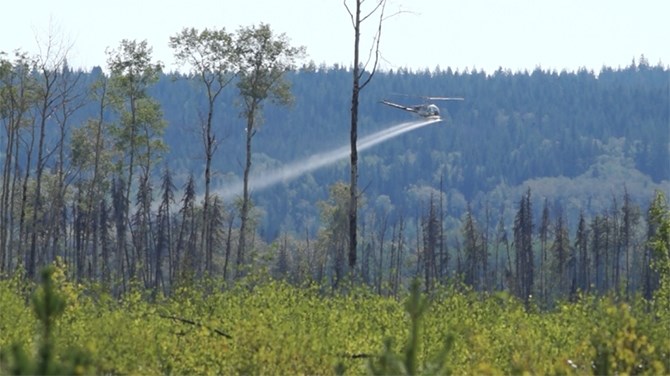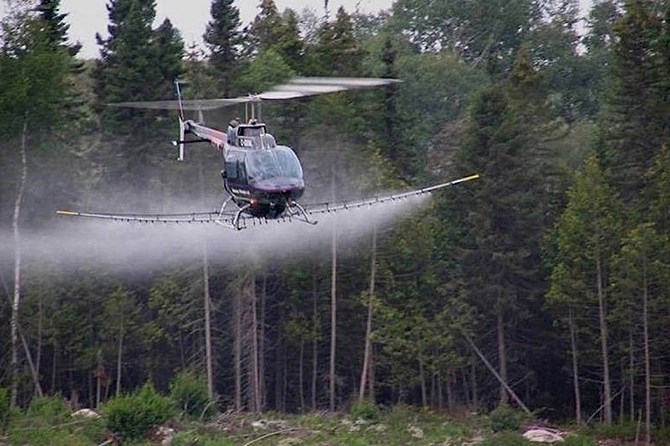
A helicopter sprays herbicide on a cut block in a B.C. forest.
Image Credit: SUBMITTED / Stop the Spray BC
November 08, 2019 - 7:45 AM
If you got a view of Okanagan Mountain Park this fall, you might have noticed something odd and rarely seen around Super Natural British Columbia — large patches of yellow from a forest in natural re-growth.
The leafy, deciduous trees like aspen and birch stand out, in contrast to vast stands of coniferous forests, largely pine, spruce and Douglas fir all across the B.C. Interior.
The 2003 wildfire destroyed much of the timber in Okanagan Mountain Park and is now growing back, but because it’s a provincial park, it’s allowed to take a natural course where leafy trees come in first to stave off the inevitable invasion of the conifers that define much of the backcountry.
It also shows just how much the province intervenes in managing its forests. Were it not a park, chances are the province’s forest management practices would give the conifers a head start by manually or chemically removing all the deciduous trees and planting new seedlings of marketable trees. It keeps the province awash in softwood lumber, but also impacts forest ecology and destroys natural fire breaks that may have helped set up some of B.C.’s worst fire seasons in the last few years.
B.C. Parks confirmed they will make no efforts to control the re-growth in Okanagan Mountain Park and we’ll get a firsthand look at the protections a natural forest may provide from fire, as well as wildlife proliferation, for a generation.

Glyphosate herbicide is applied by helicopter spraying to a logged area after seedlings are replanted.
Image Credit: SUBMITTED / Doug Pitt, Natural Resources Canada
Ministry of Forests spokesperson Jeremy Uppenborn says only 20 per cent of the province’s forests are amenable to natural coniferous regeneration. The rest are replanted manually and in some cases “vegetation management” is used to enhance and promote coniferous regeneration.
Vegetation management could involve manual, machine or chemical brushing using glyphosate, the active ingredient in RoundUp to control unwanted stands of deciduous trees like aspen and birch, which have a natural tendency to be the first species to regenerate in a new forest.
Therein lies a problem, according to James Steidle, a former tree planter and sawmill worker who now runs a woodworking company and spokesperson for “Stop the Spray B.C."
Steidle says he was through the Okanagan the year before Okanagan Mountain Park burned, and has seen the area since in photos and from a distance.
“What you are seeing there is the natural succession of our forests taking place. After a conifer-dominated stand is cut or burned and left on its own, it will grow back deciduous,” he says.
He’s seen this story before. He recalls a 2010 forest fire in central B.C. as an example.
“That was a stand of Douglas fir that burned. It’s now 100 per cent birch. That’s how nature works,” he says. “If you walk through that birch stand, you’ll see a whole bunch of fir and spruce seedlings, doing just fine. The idea of forests being continuous conifer is a myth, it’s not the way forests work. 'Ecological succession' are keywords.”
Steidle says the deciduous trees in a pure, continuous stand will fireproof that forest for the next generation, as aspen stands are much less likely to burn.
“If the Okanagan Mountain landscape looks different than surrounding forests, that’s entirely natural,” he says.

Regenerating forest in Okanagan Mountain Park.
Image Credit: Stacy Metcalf
While glyphosate is not as common in the south as it is in central B.C., the province treated 12,812 hectares in 2017, (0.01 per cent of the province) down considerably from 18,546 ha treated in 2015.
That works out to roughly 24,300 kg of glyphosate used.
Uppenborn says recent changes to reforestation practices are allowing increased levels of aspen and broadleaf trees in managed stands, which should reduce the amount of glyphosate used in future years.
While Steidle also notes that 1.4 million hectares of deciduous forest has been beaten back chemically or manually since 1982 as part of taxpayer-funded management of forests as a crop, he says movement by the province is a good sign.
“That is definitely progress,” he says. “We really need to start respecting the deciduous trees, the aspens, the birches, way more than we are now.”
As climate change and fire seasons like 2017 and 2018 show greater intensity and destruction, we’re likely to hear much more about this. Coniferous stands are highly-flammable timber waiting to burn — nearly ten times more likely to burn than in the deciduous period of forest maturity.
"Every year we replace more fire resistant forest with flammable forest, required by law and in some cases even paid for with taxpayer money through programs like Forests for Tomorrow. It makes no logical sense, especially when you realize aspen forests grow quick, sequester more CO2 than pine or spruce, reflect almost double the solar radiation relative to conifers in summer, have commercial value, and are critical trees for moose, birds, beaver, and many species of plants and insects,” he said in the opinion section of the Vancouver Sun in January, 2019.
The organization he’s a part of, Stop the Spray, is joined in part by Green Party MLA Andrew Weaver in calling on the province to significantly curtail the widespread use of glyphosate and allow more of B.C.’s forests to regenerate naturally.
Until then, keep an eye on Okanagan Mountain Park. It's one of few stands of forest growing as it should.
To contact a reporter for this story, email Steve Arstad or call 250-488-3065 or email the editor. You can also submit photos, videos or news tips to tips@infonews.ca and be entered to win a monthly prize draw.
We welcome your comments and opinions on our stories but play nice. We won't censor or delete comments unless they contain off-topic statements or links, unnecessary vulgarity, false facts, spam or obviously fake profiles. If you have any concerns about what you see in comments, email the editor in the link above.
News from © iNFOnews, 2019